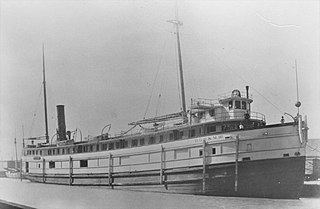This page is based on this
Wikipedia article Text is available under the
CC BY-SA 4.0 license; additional terms may apply.
Images, videos and audio are available under their respective licenses.

Newport News Shipbuilding (NNS), a division of Huntington Ingalls Industries, is the largest industrial employer in Virginia, and sole designer, builder and refueler of United States Navy aircraft carriers and one of two providers of U.S. Navy submarines. Founded as the Chesapeake Dry Dock and Construction Co. in 1886, Newport News Shipbuilding has built more than 800 ships, including both naval and commercial ships. Located in the city of Newport News, their facilities span more than 550 acres (2.2 km2), strategically positioned in one of the great harbors of the East Coast.

The Montana-class battleships were planned as successors of the Iowa class for the United States Navy, to be slower but larger, better armored, and with superior firepower. Five were approved for construction during World War II, but changes in wartime building priorities resulted in their cancellation in favor of the Essex-class aircraft carrier and Iowa class before any Montana class keels were laid.
Four ships of the United States Navy have borne the name USS Maine, named for the 23rd state:

USS Missouri (BB-63) is an Iowa-class battleship and was the third ship of the United States Navy to be named after the U.S. state of Missouri. Missouri was the last battleship commissioned by the United States and is best remembered as the site of the surrender of the Empire of Japan which ended World War II.
Four ships of the United States Navy have been named USS Missouri in honor of the state of Missouri:
Four ships of the United States Navy have been named USS Indiana in honor of the 19th state.
Eight ships of the United States Navy and United States Revenue Cutter Service have been named USS Massachusetts, after the Commonwealth of Massachusetts.

USS Kentucky (BB-66) was an uncompleted battleship originally intended to be the second ship of the Montana class. However, the urgent need for more warships at the outbreak of World War II and the U.S. Navy's experiences in the Pacific theater led it to conclude that rather than battleships larger and more heavily armed than the Iowa class, it quickly needed more fast battleships of that class to escort the new Essex-class aircraft carriers being built. As a result, hulls BB-65 and BB-66 were reordered and laid down as Iowa-class battleships in 1942.
USS Illinois may refer to:
USS South Dakota may refer to:

USS Massachusetts (BB-59), known as "Big Mamie" to her crew-members during World War II, is a battleship of the second South Dakota class. She was the seventh ship of the United States Navy to be named in honor of the sixth state, and one of two ships of her class to be donated for use as a museum ship. Massachusetts has the distinction of having fired the US Navy's first and last 16-in (406 mm) shells of the war.

USS Wisconsin (BB-64) is an Iowa-class battleship, the second ship of the United States Navy to be named in honor of the U.S. state of Wisconsin. She was built at the Philadelphia Naval Shipyard in Philadelphia, Pennsylvania and launched on 7 December 1943, sponsored by the wife of Governor Walter Goodland of Wisconsin.
Maine is a state of the United States.
Illinois is a state in the United States.
Wisconsin is a constituent state of the United States of America.

The National Museum of the United States Navy, or U.S. Navy Museum for short, is the flagship museum of the United States Navy and is located in the former Breech Mechanism Shop of the old Naval Gun Factory on the grounds of the Washington Navy Yard in Washington, D.C., United States.

5"/51 caliber guns initially served as the secondary battery of United States Navy battleships built from 1907 through the 1920s, also serving on other vessels. United States naval gun terminology indicates the gun fired a projectile 5-inch (127 mm) in diameter, and the barrel was 51 calibers long.

The 5"/25 caliber gun entered service as the standard heavy anti-aircraft (AA) gun for United States Washington Naval Treaty cruisers commissioned in the 1920s and 1930s. The goal of the 5"/25 design was to produce a heavy AA gun that was light enough to be rapidly trained manually. The gun was also mounted on pre-World War II battleships and aircraft carriers until replaced by the standard dual-purpose 5"/38 caliber gun, which was derived from the 5"/25 and was similar except for the barrel length. Guns removed from battleships were probably converted for submarine use by late 1943, while a purpose-built variant for submarines was available in mid-1944, and was widely used by them. United States naval gun terminology indicates the gun fired a projectile 5 inches (127 mm) in diameter, and the barrel was 25 calibers long.
The Standard-type battleship was a series of twelve battleships across five classes ordered for the United States Navy between 1911 and 1916 and commissioned between 1916 and 1923. These were considered super-dreadnoughts, with the ships of the final two classes incorporating many lessons from the Battle of Jutland.












